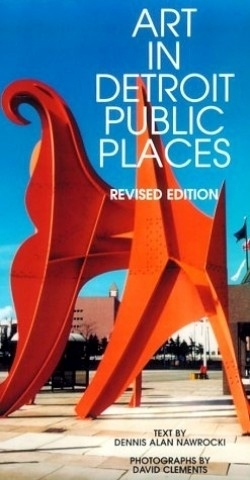Art in Detroit
Public Places
“There has always been art in public places. Long before it was made for private consumption and enjoyment, art functioned for societies in very basic and far-reaching ways,” writes the author in his introduction to the revised edition of an excellent guide first prepared twenty years ago to the wealth of public art to be found in the Detroit metropolitan area. Nawrocki, professor of art history at the Center for Creative Studies-College of Art and Design in Detroit, notes that from ancient times public works of art sought to teach and to commemorate, as well as to delight the viewer and enhance the environment. Detroit continues the tradition, celebrating its own history and heroes and ethnic diversity, while enriching its urban and suburban surroundings with an infinite variety of works of art.
In 1874, Julius Melchers, Detroit’s first sculptor, carved larger-than-life
figures of the four French pioneers, Marquette, LaSalle, Cadillac and Richard, who helped establish Michigan Territory and the city of Detroit. Originally installed in niches in the facade of the old, demolished City Hall, they now grace Wayne State University’s campus. A gift from the People of Krakow, Poland, to the city of Detroit in 1976, is a bronze cast of General Thaddeus Kosciusko astride a prancing steed. He doffs his hat to motorists and pedestrians in true cavalier fashion. Nearby, set against a white marble semi-circular wall is the Spirit of Detroit. A sixteen-foot high seated bronze figure with arms gracefully outstretched, it projects a sense of welcome. Newly selected for this edition is Sentry, a ten-foot high black and gold mask poised above the main entrance to the Charles H. Wright Museum of African American History. Modeled on the mask style of the Bambara people of Mali, the contrasting hues create a dazzling, powerful image.
Charming examples of whimsy abound also. Alexander Calder’s Jeune Fille et Sa Suite, painted bright red-orange, displays her saucy twenty-ton steel self on a triangular space in front of the Ameritech Building. A children’s favorite is Silverbolt, a lively, shiny, chrome-plated horse, fashioned out of automobile bumpers.
Each of the 120 selected art works appears in a photograph accompanied by Nawrocki’s lyrical descriptive text. The book has been organized into five
geographical sections covering a twenty-mile radius of the City of Detroit. A map is provided for each section showing the location of the works in that area. It is a practical guide, a carefully researched art history textbook and a fresh approach to the heart and history of an important American city-all in one easily portable volume.
Reviewed by
Joyce Moore
Disclosure: This article is not an endorsement, but a review. The publisher of this book provided free copies of the book to have their book reviewed by a professional reviewer. No fee was paid by the publisher for this review. Foreword Reviews only recommends books that we love. Foreword Magazine, Inc. is disclosing this in accordance with the Federal Trade Commission’s 16 CFR, Part 255.

